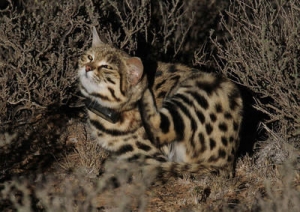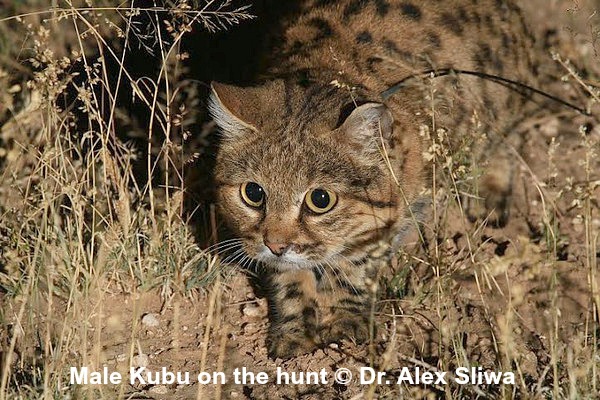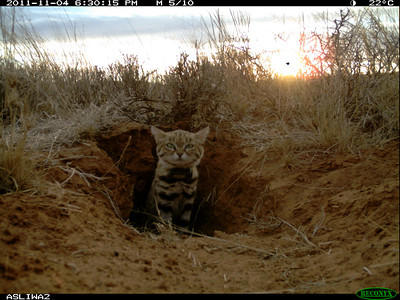
What is a Black-footed Cat?
Black-footed cats are one of the smallest wild cat species in the world, weighing just 1 – 2.5 kg (2 – 5.5 lbs).They are found only in three countries: South Africa, Namibia and Botswana. They inhabit short to medium length grass plains, scrub desert and sand plains, including the Kalahari and Karoo Deserts.
An incredibly tenacious little cat, the natives have a legend claiming these tiny cats can bring down a giraffe. While this is untrue, it pays homage to the determination of these feisty little felines.
Researchers of the Black-footed Cat Working Group often record interactions between Black-footed cats and other animals in their habitat. Their attitude proves that while they may be small, they don’t let their size stop them.
“The male Kubu was located resting in a hollow termite mound. When he became active, he sprayed several times, then caught a gerbil. He continued to forage and as a group of bat-eared foxes three times the size of the cat approached, Kubu sat and watched them. When one of the foxes came too close, Kubu slapped him and just walked on.”
Or how about this determined kitty:
“I was following one of the black-footed cats when I drove past a blue crane nest I had been checking the past week. This time when I shone my spotlight on the big birds, I noticed the bright blue eyes of the male black-footed cat next to the nest. I watched as he sniffed the nesting female’s head and neck, then tried to push underneath her to get to the chicks in the nest.”
What is known today about the home range, behaviour and diet of the Black-footed Cat has been found during this field study in South Africa. The study area is situated close to the famous diamond city of Kimberley, and ISEC Canada has been supporting this work since the project began. In 2019, researchers set up a new field study in Namibia, a country where the tiny cats have never been studied.

How Do You Learn About A Tiny Wild Cat?
Dr. Alex Sliwa captured his first Black-footed Cat in December 1992. He got closer and closer to the cats each night, eventually observing them from 15-30 metres away. After several weeks of habituating individual cats to the sound of the truck and the shine of the low powered spotlight (always held behind them) he could follow them for most of their nocturnal activity periods. He has returned to the study area in subsequent years to track and study the cats, utilizing three capture methods:
Spot lamp searching – A 4×4 vehicle drives along dirt roads at a speed of 20 km/hr while looking for the bright eye shine of cats.
Netting – Once the cats are located with spot lamps, their species identification is confirmed with binoculars. If positively identified, they are pursued by the vehicle for a short distance between 100-600 m, which results in the cat squatting low to the ground in front of the stopped vehicle. One or two people with fish landing nets get off the vehicle and net the cats.
Live trapping – Two types of live traps are used, and the doors close when the cat pulls on the baited hook. Bait is either small dead birds or small pieces of larger birds, which are freshly defrosted before being put onto the triggering mechanism of the traps. For lure, shredded pilchards, sardines in oil, cod liver oil and urine from oestral domestic cats is used. Each trap is serviced twice a day.
Captured cats are anesthetized with an intramuscular injection and covered with a blanket to shield them from lights and sounds. Upon immobilization all cats are measured, weighed, examined for general body condition, parasites, and when possible 2.0 ml of blood is drawn. After fitting a small radio collar (45-60 g), the cats are then placed in a small plastic crate for recovery.
All captured cats are released back into a den close to their capture location. A blanket is used to cover the den entrance, keeping them inside until they are fit to leave on their own.
Their Population is Decreasing
In addition to natural threats like black-backed jackals, caracals and eagle owls, these cats are increasingly being challenged by human changes to their habitat.
The average black-footed cat eats about 3,000 rodents each year. This should earn them the title of Farmer’s Friend, but they face many man-made threats:
- Poisoning of carcasses to kill larger carnivores, which the black-footed cats scavenge
- Overgrazing by livestock, which reduces their prey base
- Poisoning of locusts, which are eaten by the cats in huge numbers
- Killing by domestic dogs, which are used to chase or dig out jackals
ISEC Canada has been recognized as the longest running supporter of this project. Donors receive updates from the field in the form of an online newsletter, available only to project supporters. Won’t you join our growing team of small wild cat fans and help the Black-footed Cats?
100% of donations received go directly to the cats.
See also


Pat Bumstead
It’s not very likely that your cat is related, but send us some photos to iseccanada@gmail.com
Brianna
Hi, I probably sound crazy but I often feel like my cat is part black footed cat. She jus has some of the features so I was wondering, If I provided some pictures, if anyone would be able to clue me in? I could be completely wrong but just putting it to rest in my mind would be nice lol
Athol Marchant
I emailed a Black-footed Cat sighting to berylwa@museumsnc.co.za & to smallwildcats@gmail.com on 11 October 2021 – I just want to check if it was delivered?
Athol Marchant
Pat Bumstead
All of this information comes from the scientists who are studying this cat in their native habitat, so yes this is all accurate!
Pat Bumstead
Black-footed cats can live up to 16 years in captivity, but in the wild their lifespan is closer to 8 years.
Paris Vandeusen
My name is Paris and i am doing a special assignment on black- footed cats and i was wondering how long the lifespan is for these particularly amazing cats. Thank you!
Jordyn
Alright so here’s my sitch. My name is Jordyn and I am doing a research project based on endangered species. I really don’t know for sure if this is accurate information and I would really like to maybe NOT fail this, for science is my passion. Although I do believe that this may be accurate, could you just maybe confirm this for me? Or maybe provide further information for I need to know more than the mere basics of this highly fascinating and eye captivating cat.
Pat Bumstead
We have forwarded your comment to Dr. Alex Sliwa, Project Leader of the BFC Project. He will be in direct contact with you via email.
Maryke
Hi, I am the Ecologist for th e Mountain Zebra Camdeboo Protected Environment project. (covering over 250000 ha of farms and 2 national parks in South Africa). Would love to assist in conservation and research of this specie. Have tried to make contact with Beryl but cant seem to reach her. Some of the land owners have indicated to help us with sightings info. Is there any way you can assist me to reach her? Maryke Stern
Maureen
Sorry to hear about Sani. The kidney failure seems to be the usual thing cats die from. My orange tabby of 14.5yrs (Deechco)), means devil in eastern European language has also died from kidney failure ( I had to euthanize him). Also three other cats I had also died from that.
Cats For Africa
Hi Diana
The best person to contact is Beryl Wilson in Kimberley. She looks after the distribution data of black-footed cats in South Africa. You can contact her at:
Zoology Department McGregor Museum
Ethologist and Collections Manager – Beryl Wilson
E-mail: berylwa@museumsnc.co.za
Telephone: +27 (0) 53 839 27274
Fax: +27 (0) 53 842 1433
She is often out on the field, so give her some time to reply 🙂
If you see the cat again, try to take note of its markings – definite spots, approximate size etc. It is very easy to confuse these cats with genets and african wild cats, and as they are rare it is very important to make a positive identification. And if it is definitely a black-footed cat then Beryl can add it to the database of sightings. All verifiable sightings are most welcome!
Kind regards
Mandy
Cats For Africa
South Africa
Diana Kleyn
We live in a Gholf estate just outside Rustenburg. I suspect that I have spotted a black footed cat twice. Do you know of a population in the Rustenburg area?